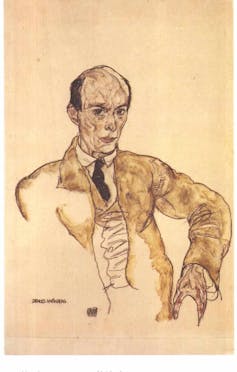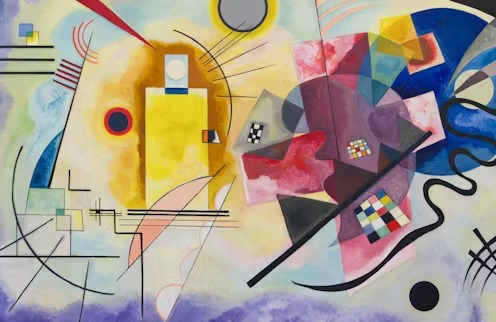2024 marks 150 years since the birth of Arnold Schoenberg (1874-1951), arguably the most influential classical composer of the 20th century.
As a significant contributor to musical modernism, Schoenberg’s work reflected a radical shift away from past classical musical forms, signifying a sharp break with tradition.
Despite his popularity and influence among composers and scholars, Schoenberg remains largely misunderstood by the general public, his music often among other modernist composition discredited as discordant noise.
Nonetheless, his compositions expressed important musical innovations that have shaped generations of subsequent composers, across music heard in concert halls and on film soundtracks.
Late Romanticism

1917 portrait of Schoenberg by Austrian expressionist artist Egon Schiele. (Wikipedia)
Born into 19th-century Vienna, Schoenberg began composing in the Romantic style.
Musical Romanticism connected with broader socio-political ideas of the time, including the idea of the artist as “genius,” the value of expressing emotions and the importance of nature in a context of intensified industrialism and technological development.
Romanticism greatly developed the musical language of 18th-century classical music by adding a greater variety of sounds and forms and a greater range of notes, instruments and genres — while still being strongly connected to earlier music.
Around the turn of the 20th century, Schoenberg’s musical language evolved to be similar to the late Romanticism of Richard Strauss and Gustav Mahler, who were both inspired by the innovative harmonies of Richard Wagner.
Thus, Mahler, Strauss and Schoenberg formed the first wave of musical modernism.
However, Mahler tragically died in 1911, and Strauss became a more conservative composer, leaving Schoenberg as the flag-bearer of musical modernism.
‘Air from another planet’
Around 1910, Schoenberg abandoned Romanticism, as he felt there was nothing left to express.
In the fourth movement of his String Quartet No. 2 (1908), Schoenberg added poetry. This was an unusual addition to a genre normally without text. The poetry, penned by Stefan George and sung by a solo soprano, announced the departure from traditional music:
“Ich fühle luft von anderem planeten (I feel air from another planet).”
Schoenberg continued to explore heightened emotions.
In his melodramatic song cycle, Pierrot Lunaire (1912), a “moonstruck” clown, Pierrot (a character from the Italian commedia dell’arte, sings a number of angst-filled melancholic poems.
Schoenberg’s ‘Pierrot Lunaire’ (1913).
This marked the beginning of Schoenberg’s “expressionism,” where he sought to radically distort traditional musical elements to explore heightened emotions.
Abstract expressionism in music
Schoenberg’s musical expressionism is often compared to the paintings of his friend and fellow expressionist, Wassily Kandinsky.
Schoenberg and Kandinsky had a sustained friendship from their first meeting in 1911, and they inspired each other’s artwork.
Kandinsky moved towards abstract art, while Schoenberg moved towards the music parallel of “atonality,” meaning away from existing musical structures of keys and traditional chords.
‘How did Schoenberg compose Pierrot Lunaire?’ video by composer Samuel Andreyev.
The result was the sound of more musical tension that Schoenberg called the “emancipation of dissonance.”
Serialism
However, Schoenberg still felt limited by expressionism.
In response, he began to use a novel compositional technique known as the “12-tone technique” or “serialism.”
In 12-tone compositions, all 12 tones of the western tuning system are repeated and varied in successions called “rows.”
By contrast, traditional composers typically employed only around seven or eight tones from a major or minor scale.
Schoenberg’s Suite for Piano (1923) that premiered in 1924 used this technique, making 2024 the centenary of serialism.
Schoenberg’s Suite for Piano (1923)
Serialism went on to strongly influence many composers who further developed the technique, such as the avant-garde Milton Babbitt, recipient of a 1982 Pulitzer Prize in composition, and Pierre Boulez.
Film composers have taken up serialism as an important technique, employing this to yield a high degree of dissonance and ethereal sounds.
This is heard in films such as Planet of the Apes (1968), with what has been called a “landmark” score composed by Jerry Goldsmith.
Schoenberg employed his own serialism in his Accompaniment to a Film Scene. However, as music theorist Orit Hilewicz notes, the piece wasn’t composed specifically for film, but for concert performance.
‘Colours’ and the quality of sound
Schoenberg was also instrumental in developing the quality of sound — known as “timbre” — as an important musical parameter. Timbre refers to how the same notes played at the same volumes — and by different instruments — can have very different qualities of sound, such as sounding pure, sharp, dull, blended or distorted.
In Farben (“Colours”), the third movement of Schoenberg’s Five Orchestral Pieces (1909), the pitch stays largely constant, while a blend of instruments continuously changes to create a variety of different “colours” or timbres. This is one of the first works to experiment with timbre.
Today, timbre is a key musical parameter. Schoenberg’s pioneering of timbre has been influential across many genres of music, including in film scores seeking to establish atmosphere and even arguably in popular styles.
Memorializing the Holocaust
Schoenberg’s use and innovation of musical elements to express dissonance was also used to sonically speak to the horrors of the Holocaust.
Being Jewish, Schoenberg was forced to migrate to the United States after the Nazis seized power in Germany in 1933, eventually settling in Los Angeles.
In 1947, Schoenberg composed A Survivor from Warsaw as a memorial to the victims. The work is scored for men’s chorus and orchestra. A narrator recites terrifying conditions of the Warsaw ghetto over the discordant and fragmented orchestral writing.
Despite being only seven minutes long, the work has had a powerful effect on audiences. Musicologist Joy Calico has examined varied reception of the work as it circulated through West Germany, Austria, Norway, East Germany, Poland and Czechoslovakia during the Cold War.
She also notes that some found A Survivor from Warsaw to resemble a horror film soundtrack, and thus to be cliché. Yet ironically these “clichés” were actually first developed by Schoenberg in the 1910s and 1920s before being borrowed by Hollywood composers, and then re-employed by Schoenberg.
‘A Survivor from Warsaw’ (1947).
This demonstrates the immense influence of Schoenberg’s music during his own lifetime.
Innovations from tradition
Despite Schoenberg’s radical innovations, he remained connected to the traditions of classical music and ensured his students mastered traditional methods of composition. Schoenberg believed one needed to understand traditional forms of historical music in order to inform the music of the future. Schoenberg’s teaching methods are still widely employed, including through the work of music theorist William Caplin.
In the words of Kandinsky, Schoenberg’s “music leads us into a realm where musical experience is a matter not of the ear but of the soul alone, and at this point the music of the future begins.”



 How ‘dupes’, fast fashion and China’s economic slowdown spell disaster for the luxury sector
How ‘dupes’, fast fashion and China’s economic slowdown spell disaster for the luxury sector  Why your retirement fund might soon include cryptocurrency
Why your retirement fund might soon include cryptocurrency  Toni Braxton’s Niece Reveals Painful Childhood, Shocking Claims of Abuse and Abandonment Stir Controversy
Toni Braxton’s Niece Reveals Painful Childhood, Shocking Claims of Abuse and Abandonment Stir Controversy  The book that sparked a revolution: One Hundred Years of Solitude, the literary masterpiece now adapted for TV
The book that sparked a revolution: One Hundred Years of Solitude, the literary masterpiece now adapted for TV  Dune: Prophecy – the prequel series takes liberties with the Herberts’ vision, but not for the worse
Dune: Prophecy – the prequel series takes liberties with the Herberts’ vision, but not for the worse  Informal mining in South Africa is here to stay. Police brutality won’t end it - here’s what will
Informal mining in South Africa is here to stay. Police brutality won’t end it - here’s what will  Scott Jennings Stuns Media World: Conservative Firebrand Joins Liberal Los Angeles Times Editorial Board—'The Debate Just Got Hotter!
Scott Jennings Stuns Media World: Conservative Firebrand Joins Liberal Los Angeles Times Editorial Board—'The Debate Just Got Hotter!  What is a migrant? What is ICE? 10 terms to help you understand the debate over immigration
What is a migrant? What is ICE? 10 terms to help you understand the debate over immigration  Nigerian TikTok star Charity Ekezie uses hilarious skits to dispel ignorance about Africa
Nigerian TikTok star Charity Ekezie uses hilarious skits to dispel ignorance about Africa  Jennifer Lopez’s Ex Casper Smart Faces Police Raid Amid Alleged Marijuana Grow Operation
Jennifer Lopez’s Ex Casper Smart Faces Police Raid Amid Alleged Marijuana Grow Operation  While Hollywood ignored stories of Black resistance, Cuban filmmakers celebrated Black power
While Hollywood ignored stories of Black resistance, Cuban filmmakers celebrated Black power  Nintendo Switch 2 and anticipated sequels – what to look forward to in gaming in 2025
Nintendo Switch 2 and anticipated sequels – what to look forward to in gaming in 2025  Kyoto: timely and enthralling play about first climate treaty reveals potent power of consensus
Kyoto: timely and enthralling play about first climate treaty reveals potent power of consensus  Mariah Carey’s Holiday Hit ‘All I Want For Christmas Is You’ Soars Again—‘Christmas Queen Is Back!’ Fans Declare
Mariah Carey’s Holiday Hit ‘All I Want For Christmas Is You’ Soars Again—‘Christmas Queen Is Back!’ Fans Declare  Regeneratively farmed is the new buzz label on supermarket shelves – but what does it actually mean?
Regeneratively farmed is the new buzz label on supermarket shelves – but what does it actually mean? 
































